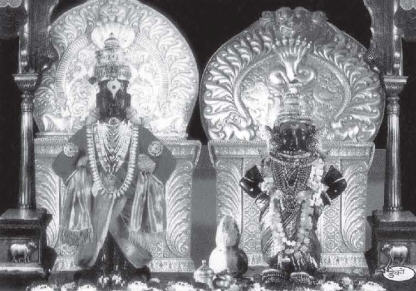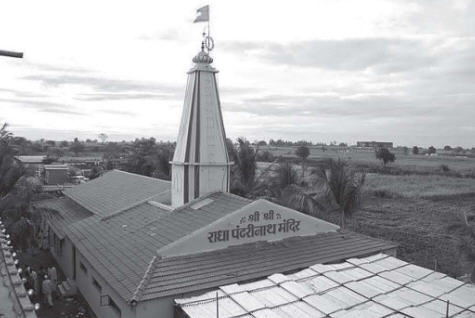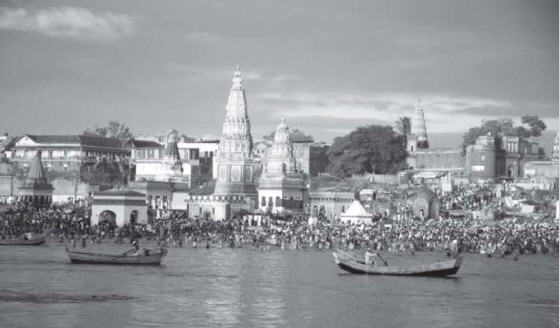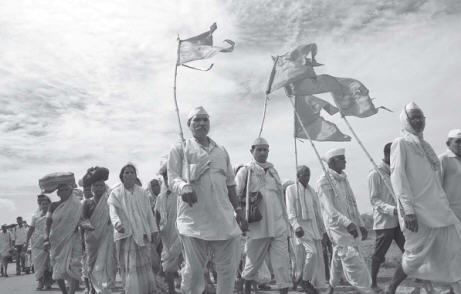
The holy site of Pandharpur unites two powerful bhakti movements
that will spread the holy names of the Lord all over the world.
Oh, most ISKCON followers are well-off, intelligent city dwellers, the elite, quite different from the simple rural devotees of Lord Vitthala of Pandharpur.” Time and again people have pointed this out to me, often with an accusatory undertone. It’s as if having a predominantly urban following poses a threat to ISKCON’s spiritual credibility. But during my recent trip to Pandharpur, as I reflected on this disturbing perception, I found it gradually replaced by an exhilarating prospect.
From the balcony in my room at the ISKCON Pandharpur guesthouse, I got a panoramic view of Sri Pandharpur Dhama. Everything one comes to Pandharpur for lay before my eyes to behold and savor.
ksetresu tirthesvatha daivatesu
bhaktesu sarvesv iha vai garistham
sri pundarikam kila candrabhaga
sri vitthalaste muni pundarikah
(Padma Purana 32.44)
“The best holy place, holy waters, deity, and devotee are Pandharpur, the Chandrabhaga, Lord Vitthala, and Pundalika respectively.”
The river Bhima, known here as the Chandrabhaga (“moon’s crescent”) because of its path, flowed from right to left, cutting across a wide expanse of the holy land. Almost directly in front of me and across the river, only two hundred meters from where I stood, rose Pandharpur’s most precious possession: the famous Sri Vitthala Rukmini Temple, which houses the ancient Deity of Lord Vitthala. Densely dotting the opposite river bank I saw a multitude of devotees eagerly bathing in the Chandrabhaga’s holy waters.
Pandharpur, situated in the Solapur district of Maharashtra, is Maharashtra’s spiritual capital. The image of Lord Vitthala, with His hands on His waist, standing on a brick, waiting for His devotee, is ingrained in the consciousness of most Maharashtrians. Every year for centuries now, thousands upon thousands of pilgrims from villages all over Maharashtra and from Gujarat, Karnataka, and Andhra Pradesh, walk to Pandharpur with unflinching faith in Lord Vitthala’s protection as an offering of devotion. During their love-walk (vari), these varkaris immerse themselves in remembering the Lord and chanting His holy names, playing musical instruments like karatalas (hand cymbals) and mrdangas or other drums to accompany their singing. Leading up to the Asadha Sukla and Kartika Sukla Ekadashis, devotees walk 15–20 days to take darshana of their Lord Vitthala, who is always eagerly waiting for them. No one seems to mind that approximately a hundred thousand others are vying for their Lord’s darshana too.
What Makes Pandharpur a Dhama?
The Lord’s place of residence is called a dhama. A dhama is also a place where remembrance of the Lord comes naturally. Therefore, places where the Lord or His pure devotees have visited or performed pastimes are dhamas. The Lord also declares in the Padma Purana that He resides wherever His devotees are glorifying Him.
naham tisthami vaikunthe
yoginam hrdayesu va
tatra tisthami narada
yatra gayanti mad-bhaktah
“I am not in Vaikuntha nor in the hearts of the yogis. I remain where My devotees engage in glorifying My activities.”
Pandharpur fits all the above definitions of a dhama. Lord Krishna, the emperor of Dvaraka, once came here in search of His beloved wife Rukmini, who was upset. While here, He remembered His great devotee Pundalika. On reaching Pundalika’s house, He saw Pundalika serving His Vaishnava parents. Pundalika, although overjoyed to see the Lord personally at his door, asked Him to wait on a brick while he finished serving his parents. The Lord, His heart overflowing with love for His devotee, patiently stood on the brick, His hands on His waist, waiting for His devotee to attend to Him. Pundalika later requested the Lord to stay in Pandharpur forever and bestow spiritual perfection on anyone who merely took His darshana. Of course, the Lord agreed. In recent times, another great devotee, Tukarama, visited Pandharpur regularly. He also broadcasted the congregational chanting of the Lord’s holy names (sankirtana) throughout Maharashtra, so much so that Pandharpur and sankirtana are now inseparable.
Pandharpur and ISKCON

Sankirtana and ISKCON are also inseparable. ISKCON is the modern-day home of the worldwide sankirtana movement and is popularly known all over the world as the Hare Krishna movement after the Hare Krishna mantra sankirtana that is its essential activity. While millions know about Pandharpur and many know about ISKCON, few seem to know about ISKCON’s connections with Pandharpur, both historical and contemporary.
To my left, as I looked down from the first floor balcony of the ISKCON Pandharpur guesthouse, I saw a small structure of columns supporting a dome. Beneath the dome, on a raised platform, three pairs of footprints are installed. The soles of Lord Vishnu’s lotus feet in each form are marked with distinctive symbols, and these three pairs of footprints depict the symbols on the lotus feet of Lord Caitanya, Lord Nityananda, and Lord Visvarupa. Visvarupa, the elder brother of Lord Caitanya, is an incarnation of Lord Balarama, who left this world in Pandharpur after he had traveled all over India. Lord Nityananda received spiritual initiation from Sri Laksmipati Tirtha in Pandharpur, and Lord Caitanya Himself visited and stayed at Pandharpur during His travels around India. The great Gaudiya Vaishnava spiritual master Bhaktivinoda Thakura sings, gaur amara, je saba sthane, karalo bhramana range, se-saba sthana heribo ami, pranayi-bhakata-sange: “I aspire to see, in the company of loving devotees, all the places visited by Lord Caitanya.” Srila Prabhupada writes, “A devotee should make a point of visiting all the places where Sri Caitanya Mahaprabhu performed His pastimes. Indeed, pure devotees of Sri Caitanya Mahaprabhu even want to see the places He simply visited for only hours or minutes.” This is the 500-year-old historical connection between Pandharpur and ISKCON.
Today, under the leadership of His Holiness Lokanatha Swami, ISKCON has a temple in Pandharpur Sri Sri Radha Pandharinatha Temple. Srila Prabhupada once commented, “Our Lokanatha Swami is just like Saint Tukarama. The whole of India and specifically Maharashtra is enthused with Krishna. Now you have to revive their Krishna consciousness. This is Tukarama’s country, but now they are becoming bad politicians. So revive them by the process of the sankirtana movement. I am very glad that you are preaching village to village and will cover all of Maharashtra.” Today, Lokanatha Swami is the head of ISKCON’s international Padayatra Ministry. Under his guidance many padayatras have been organized all over the world. But Lokanatha Swami, with his childhood rooted in varis to Pandharpur, and because his spiritual master likened him to the Tukarama of ISKCON, has a special place in his heart for Pandharpur.
ISKCON’s Contribution to Pandharpur

Chandrabhaga River
Serving the Lord, the devotees, and the dhama is central to the bhagavata culture and the sankirtana movements of both Tukarama and ISKCON espouse. Lord Krishna says in the Bhagavad-gita (18.68–69) that no one is dearer to Him than those who spread the message of the Gita among devotees. Pandharpur is full of devotees, and ISKCON’s expertise in presenting the Bhagavad-gita’s message is well-known. In his talks in India and abroad, Lokanatha Swami often speaks about Lord Vitthala. Consequently, many devotees from around the world have started to visit Pandharpur. ISKCON Pandharpur also reaches out to the nearby rural communities, where their programs are attended by the local folk. Lokanatha Swami’s Marathi book Bhu-Vaikuntha, compiled after a lot of scriptural research, reveals the unique spiritual stature of Pandharpur and weeds out non-scriptural and anti-scriptural misconceptions about the path of pure bhakti that is this dhama’s very essence.
During the annual varis to Pandharpur, ISKCON’s Bhaktivedanta Hospital conducts free medical camps for residents of Pandharpur, and ISKCON’s Food for Life organization distributes free wholesome prasada to the varkaris. This year ISKCON served around three hundred thousand devotees in these ways. Over the years, the authorities of the Sri Vitthala-Rukmini Temple and ISKCON Pandharpur have worked together on many occasions. ISKCON also conducts regular programs inside the Vitthala-Rukmini Temple. ISKCON’s regular and significant contributions over the years have not gone unnoticed by the government, either. The Government of Maharashtra wishes to transform Pandharpur into an international destination so that Lord Vitthala’s glories may spread throughout the world. Looking at the amazing transformations ISKCON’s presence has brought in holy places like Mayapur and Vrindavana, the government has asked ISKCON to help lead this task. And ISKCON Pandharpur has enthusiastically accepted the government’s request that they arrange for the construction of a bathing ghata. This ghata which will be known as Prabhupada Ghata will be on the ISKCON temple’s side of the river. With lawns, fountains, and other relaxation areas, it promises to make the pilgrims’ visit to Pandharpur convenient, thus making Pandharpur an even more attractive destination.
Confluence at Pandharpur

At first look, the rural devotees of Lord Vitthala, with their modest means and simple ways, seem to have nothing in common with ISKCON’s predominantly urban followers. Those who have given their hearts to the varkaris sometimes find it hard to appreciate ISKCON’s methods. Time and again I have come across people, some genteel, some vehement, who say that ISKCON caters only to the well-educated urban elite. “Why doesn’t ISKCON do something for the rural poor?”
I was stumped when someone first asked me this question. It struck me as odd, as if there is no meeting place between varkaris and urbanite devotees. The apparent conflict is easily resolved in light of how and where these two glorious sankirtana movements started. Tukarama lived and started preaching the message of love of God in the nondescript Indian village of Dehu, whereas Srila Prabhupada was a Calcutta boy and later traveled to the United States to begin his preaching mission in New York City. How can we expect the two movements to have the same kind of followers at least initially?
But the bhagavata culture makes no distinction between rich and poor among its followers. To judge a spiritual movement based on the bank balance of its adherents instead of its teachings is material vision. But putting that aside, as ISKCON’s various activities in rural Pandharpur prove, ISKCON doesn’t intend to restrict itself to any particular strata of society. ISKCON’s mission is to spread Krishna’s holy name to every town and village on earth. Since most of India lives in villages, it’s only a matter of time before ISKCON will have more rural followers than urban in India. To realize that day when the whole world, villager or city-bred, chants the holy name is the mission of all the sincere followers of Lord Caitanya, Srila Prabhupada, and ISKCON.
ISKCON in Pandharpur symbolizes the confluence of two great bhakti traditions, one rural and one urban. The proposed Prabhupada Ghata promises to be the site where the two bhakti currents will mingle and embrace each other. Then the combined force of these two great currents will wash away materialistic standpoints that allow us to think one current is holier than the other. Both are holy.
Looking down from my vantage point, a balcony in the ISKCON Pandharpur guesthouse, I saw in my mind’s eye thousands of devotees carpeting the near bank of the Chandrabhaga at the place where Prabhupada Ghata will soon appear, and many others eagerly dipping into the sacred and refreshing waters.
After a confluence, there is no clear distinction between the constituent currents. Similarly, in the current of bhakti that will now flow from Pandharpur, it will be hard to distinguish between the rural and the urban currents; they will unite and flow together with great force and reverberate the holy names of Lord Vitthala in roaring sankirtana.
Abhijit Toley did M.Tech.in Computer Science from IIT Mumbai and is presently working as a Principal Software Engineer in an MNC in Pune, Maharashtra. Check his blog at http://thebandwagonofmoltengold.blogspot.com/
